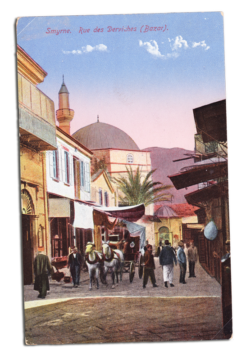The area we know today as Kemeraltı was an inner harbor of İzmir until the mid-17th century. In addition to being a commercial center, this region witnessed significant events in Turkish history. In the 1330s, Aydınoğlu Umur Bey fought battles with his fleet in front of the inner harbor and captured Ok Castle (Ok Kalesi). Thus, along with Upper İzmir (Kadifekale), he brought the entire city of İzmir under his rule.
In 1344, the Crusaders reclaimed Lower İzmir, including the inner harbor and its surroundings. Aydınoğlu Umur Bey made several attempts to recapture the area, and during one of these campaigns, he was martyred in front of Ok Castle in 1348.
In 1402, İzmir was once again entirely brought under Turkish rule. After the Battle of Ankara, Timur arrived in İzmir, captured Ok Castle, and from that day forward, Turkish sovereignty in İzmir, which continues to this day, was established.
When Timur left Anatolia, he restored the Turkish principalities that the Ottoman Empire had dissolved, and İzmir was once again placed under the rule of the Aydinids. During this period, İzmiroğlu Cüneyd Bey, who governed İzmir between 1405 and 1425, became a historically significant figure due to his political maneuvers during and after the Interregnum Period. His policies after Murad II ascended the throne drew the attention of the Ottoman Empire, and in 1425, after being defeated in battle, İzmir officially came under Ottoman rule.
During the Ottoman period, İzmir remained a small coastal town until the early 17th century, primarily functioning as an agricultural region producing goods for the capital, İstanbul. However, from the late 16th century onwards, the Ottoman-Iran War significantly altered trade routes, turning İzmir into a key commercial hub between the East and the West. During this time, the inner harbor and its surroundings became increasingly active in trade. Over time, the inner harbor silted up, and commercial buildings constructed around the inner harbor, primarily hans, as well as storage facilities and other structures, laid the foundation for what is known today as Kemeraltı Bazaar, an area synonymous with İzmir’s urban identity.
Life in Kemeraltı
As trade centered in İzmir expanded, Kemeraltı, the heart of this commerce, also grew, with new buildings being constructed to meet the increasing demand. Today, Kemeraltı and the archaeological site of Smyrna Agora are separated only by a single road. Just as the Smyrna Agora served as the public space of its time, Kemeraltı has functioned as the most important public space of modern İzmir since the mid-18th century.
Going beyond three-dimensional models and envisioning Kemeraltı as it once was, we can picture merchants from the East and West engaging in trade, the bustling hans where these transactions took place, the courtyards of these hans, and the narrow streets filled with conversations in multiple languages. On one street corner, there is a mosque; on another, a synagogue; a little further, a church—an embodiment of the cosmopolitan culture that was once a microcosm of an empire.
